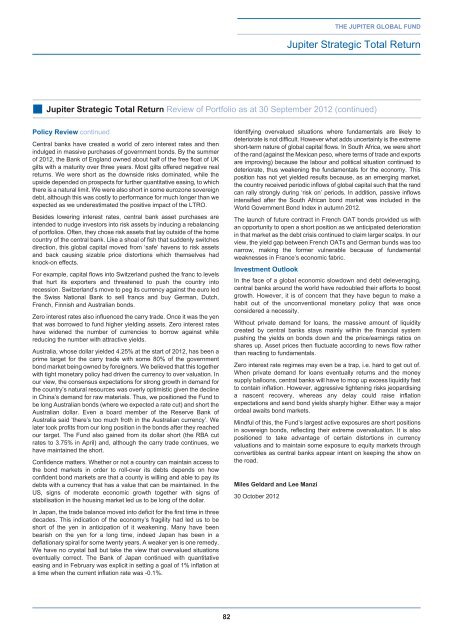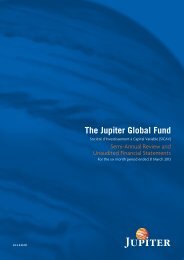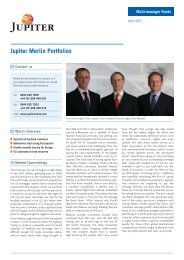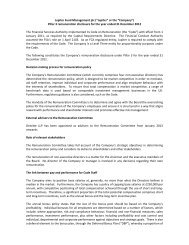The Jupiter Global Fund - Jupiter Asset Management
The Jupiter Global Fund - Jupiter Asset Management
The Jupiter Global Fund - Jupiter Asset Management
Create successful ePaper yourself
Turn your PDF publications into a flip-book with our unique Google optimized e-Paper software.
the jupiter global fund<br />
<strong>Jupiter</strong> Strategic Total Return<br />
■■<strong>Jupiter</strong> Strategic Total Return Review of Portfolio as at 30 September 2012 (continued)<br />
Policy Review continued<br />
Central banks have created a world of zero interest rates and then<br />
indulged in massive purchases of government bonds. By the summer<br />
of 2012, the Bank of England owned about half of the free float of UK<br />
gilts with a maturity over three years. Most gilts offered negative real<br />
returns. We were short as the downside risks dominated, while the<br />
upside depended on prospects for further quantitative easing, to which<br />
there is a natural limit. We were also short in some eurozone sovereign<br />
debt, although this was costly to performance for much longer than we<br />
expected as we underestimated the positive impact of the LTRO.<br />
Besides lowering interest rates, central bank asset purchases are<br />
intended to nudge investors into risk assets by inducing a rebalancing<br />
of portfolios. Often, they chose risk assets that lay outside of the home<br />
country of the central bank. Like a shoal of fish that suddenly switches<br />
direction, this global capital moved from ‘safe’ havens to risk assets<br />
and back causing sizable price distortions which themselves had<br />
knock-on effects.<br />
For example, capital flows into Switzerland pushed the franc to levels<br />
that hurt its exporters and threatened to push the country into<br />
recession. Switzerland’s move to peg its currency against the euro led<br />
the Swiss National Bank to sell francs and buy German, Dutch,<br />
French, Finnish and Australian bonds.<br />
Zero interest rates also influenced the carry trade. Once it was the yen<br />
that was borrowed to fund higher yielding assets. Zero interest rates<br />
have widened the number of currencies to borrow against while<br />
reducing the number with attractive yields.<br />
Australia, whose dollar yielded 4.25% at the start of 2012, has been a<br />
prime target for the carry trade with some 80% of the government<br />
bond market being owned by foreigners. We believed that this together<br />
with tight monetary policy had driven the currency to over valuation. In<br />
our view, the consensus expectations for strong growth in demand for<br />
the country’s natural resources was overly optimistic given the decline<br />
in China’s demand for raw materials. Thus, we positioned the <strong>Fund</strong> to<br />
be long Australian bonds (where we expected a rate cut) and short the<br />
Australian dollar. Even a board member of the Reserve Bank of<br />
Australia said ‘there’s too much froth in the Australian currency’. We<br />
later took profits from our long position in the bonds after they reached<br />
our target. <strong>The</strong> <strong>Fund</strong> also gained from its dollar short (the RBA cut<br />
rates to 3.75% in April) and, although the carry trade continues, we<br />
have maintained the short.<br />
Confidence matters. Whether or not a country can maintain access to<br />
the bond markets in order to roll-over its debts depends on how<br />
confident bond markets are that a county is willing and able to pay its<br />
debts with a currency that has a value that can be maintained. In the<br />
US, signs of moderate economic growth together with signs of<br />
stabilisation in the housing market led us to be long of the dollar.<br />
In Japan, the trade balance moved into deficit for the first time in three<br />
decades. This indication of the economy’s fragility had led us to be<br />
short of the yen in anticipation of it weakening. Many have been<br />
bearish on the yen for a long time, indeed Japan has been in a<br />
deflationary spiral for some twenty years. A weaker yen is one remedy.<br />
We have no crystal ball but take the view that overvalued situations<br />
eventually correct. <strong>The</strong> Bank of Japan continued with quantitative<br />
easing and in February was explicit in setting a goal of 1% inflation at<br />
a time when the current inflation rate was -0.1%.<br />
Identifying overvalued situations where fundamentals are likely to<br />
deteriorate is not difficult. However what adds uncertainty is the extreme<br />
short-term nature of global capital flows. In South Africa, we were short<br />
of the rand (against the Mexican peso, where terms of trade and exports<br />
are improving) because the labour and political situation continued to<br />
deteriorate, thus weakening the fundamentals for the economy. This<br />
position has not yet yielded results because, as an emerging market,<br />
the country received periodic inflows of global capital such that the rand<br />
can rally strongly during ‘risk on’ periods. In addition, passive inflows<br />
intensified after the South African bond market was included in the<br />
World Government Bond Index in autumn 2012.<br />
<strong>The</strong> launch of future contract in French OAT bonds provided us with<br />
an opportunity to open a short position as we anticipated deterioration<br />
in that market as the debt crisis continued to claim larger scalps. In our<br />
view, the yield gap between French OATs and German bunds was too<br />
narrow, making the former vulnerable because of fundamental<br />
weaknesses in France’s economic fabric.<br />
Investment Outlook<br />
In the face of a global economic slowdown and debt deleveraging,<br />
central banks around the world have redoubled their efforts to boost<br />
growth. However, it is of concern that they have begun to make a<br />
habit out of the unconventional monetary policy that was once<br />
considered a necessity.<br />
Without private demand for loans, the massive amount of liquidity<br />
created by central banks stays mainly within the financial system<br />
pushing the yields on bonds down and the price/earnings ratios on<br />
shares up. <strong>Asset</strong> prices then fluctuate according to news flow rather<br />
than reacting to fundamentals.<br />
Zero interest rate regimes may even be a trap, i.e. hard to get out of.<br />
When private demand for loans eventually returns and the money<br />
supply balloons, central banks will have to mop up excess liquidity fast<br />
to contain inflation. However, aggressive tightening risks jeopardising<br />
a nascent recovery, whereas any delay could raise inflation<br />
expectations and send bond yields sharply higher. Either way a major<br />
ordeal awaits bond markets.<br />
Mindful of this, the <strong>Fund</strong>’s largest active exposures are short positions<br />
in sovereign bonds, reflecting their extreme overvaluation. It is also<br />
positioned to take advantage of certain distortions in currency<br />
valuations and to maintain some exposure to equity markets through<br />
convertibles as central banks appear intent on keeping the show on<br />
the road.<br />
Miles Geldard and Lee Manzi<br />
30 October 2012<br />
82








